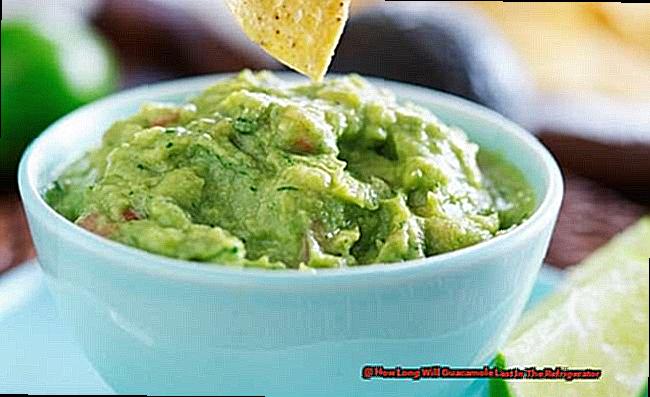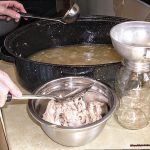Are you a guacamole aficionado like myself? If so, you know the struggle of trying to savor every last bite of your homemade guac before it spoils. But fear not, fellow avocado lovers. Today, we’re delving into the fascinating world of guacamole shelf life in the refrigerator. So buckle up and get ready to become a guac expert.
Let’s start with the basics: The average shelf life of homemade guacamole in the fridge is around 3-4 days. However, store-bought guacamole can last a bit longer, usually 5-7 days. Why is there such a difference? Well, store-bought versions often contain preservatives that help extend their shelf life.
But what if you want to make your own delicious guac without any added chemicals? Don’t worry, there are ways to prolong its lifespan. One trick is to add a squeeze of lemon or lime juice before storing it in an airtight container or tightly covered with plastic wrap. This helps prevent oxidation and browning of the avocados.
Another option is freezing your guacamole for later use. However, keep in mind that this may alter its texture and taste slightly. So if you’re someone who values the perfect creamy consistency of your dip, this may not be the best option for you.
Now let’s talk about how to tell if your beloved guac has gone bad. The most obvious sign is brown spots on top and a sour smell. Trust me, no one wants to eat spoiled guacamole – it’s just not worth it.
And finally, a pro tip: Always use clean utensils when scooping out your guacamole from the container. This helps prevent contamination and bacteria growth, which can lead to spoilage.
So there you have it – everything you need to know about the shelf life of guacamole in the refrigerator. Armed with this knowledge, you can confidently make that extra batch of guac without any worries. Just remember to consume it within the recommended time frame for optimal freshness. Happy dipping.
Contents
- 1 How to Store Guacamole?
- 1.1 Transfer the guacamole into an airtight container
- 1.2 Pack it down and remove air bubbles
- 1.3 Add a layer of water or lime juice
- 1.4 Cover with plastic wrap and lid
- 1.5 Store in the fridge for up to 3 days
- 1.6 Check for expiration date
- 1.7 Consume leftovers within 1-2 days
- 1.8 Freeze for longer storage
- 1.9 Watch out for spoilage signs
- 1.10 Enjoy its nutritional benefits
- 2 How Long Does Guacamole Last?
- 3 How to Tell If Guacamole Has Gone Bad?
- 4 Why Guacamole?
- 5 How to Tell If Guacamole Has Gone Bad?
- 6 Why Guacamole?
- 7 Conclusion
How to Store Guacamole?
If you’re wondering how to store guacamole in the fridge, the best approach is to transfer it to an airtight container and limit air exposure by packing it down with a spoon. To further preserve its freshness, adding a layer of water or lime juice over the top is also recommended. Here’s a step-by-step guide on how you can properly store guacamole in your refrigerator:
Transfer the guacamole into an airtight container
Use a spoon to scoop the guacamole into a container with a tight-fitting lid. This will effectively prevent air from entering and causing the guacamole to spoil.
Pack it down and remove air bubbles
Gently use the back of a spoon to pack the guacamole down and eliminate any air bubbles. This will also help prevent browning.
Add a layer of water or lime juice
Pour a small amount of water or lime juice over the top of the guacamole. This creates a barrier between the air and guacamole, preventing it from turning brown.
Cover with plastic wrap and lid
For additional protection against air exposure, cover the container with plastic wrap before sealing it with the lid.
Store in the fridge for up to 3 days
Place the container in your refrigerator and consume within 1-2 days for optimal freshness.
Moreover, here are some helpful tips for storing guacamole in your fridge:
Check for expiration date
If you have store-bought guacamole, always check the “best by” date for maximum freshness.
Consume leftovers within 1-2 days
If you have homemade guacamole, make sure to consume it within 1-2 days when stored in the fridge.
Freeze for longer storage
For extended storage, you can blend your guacamole smoothly and freeze it in ice cube trays for easy portioning.
Watch out for spoilage signs
If you notice your guacamole turning brown, developing mold, changing in taste or smell, or having a watery texture, it’s best to discard it.
Enjoy its nutritional benefits
Guacamole is made from nutrient-rich avocados and lime juice, making it a healthy and delicious snack or addition to meals.
How Long Does Guacamole Last?

When it comes to the fridge life of guacamole, there are a number of factors that can impact its longevity. These include the quality of ingredients, how it is stored, and how quickly it is refrigerated.
Other factors that can affect its shelf life include signs of spoilage, the cleanliness of the preparation process, and the use of preservatives like lemon or lime juice. Let’s take a closer look at these factors to better understand how they can influence the shelf life of guacamole.
Ingredient Quality:
The quality of avocados used in guacamole plays a major role in its shelf life. Ripe avocados that are soft to the touch will provide a longer fridge life compared to unripe ones. Similarly, the freshness and quality of other ingredients such as tomatoes, onions, cilantro, and lime juice can also impact the overall freshness and shelf life of guacamole.
Hygiene:
Proper hygiene during preparation is crucial to prevent cross-contamination and bacterial growth in guacamole. Using clean utensils and washing ingredients thoroughly can help maintain the freshness and extend the shelf life of this tasty dip.
Quick Refrigeration:
Refrigeration is key to preserving the freshness of guacamole. After making your guac, it’s important to transfer it promptly into an airtight container and refrigerate it at a temperature below 40°F (4°C). This will slow down bacterial growth and prevent spoilage.
Signs of Spoilage:
It’s important to keep an eye on the appearance and smell of guacamole for any signs of spoilage. If you notice any discoloration, sour smell, or mold growth, it’s best to toss out the guacamole immediately.
Proper Storage:
Storing guacamole in an airtight container is essential to minimize air contact and prevent oxidation. It can also be helpful to divide it into smaller portions for storage, as this will reduce exposure to air and prolong its freshness.
Preservative Power:
Adding lemon or lime juice to guacamole not only enhances its flavor, but also helps prevent browning due to its citric acid content. Placing plastic wrap directly on top of the dip can also act as a barrier against oxygen and preserve its vibrant green color.
In conclusion, there are a variety of factors that can affect the fridge life of guacamole.
How to Tell If Guacamole Has Gone Bad?
When it comes to determining if guacamole has gone bad before consuming it, there are a few key indicators to keep in mind. These include changes in color, texture, smell, and taste. It’s crucial to regularly check these factors, especially if the guacamole has been stored for an extended period of time.
Color
One of the most obvious signs that guacamole has gone bad is a change in color. Fresh guacamole should have a vibrant green hue, but if it starts to turn brown or gray, it’s a clear indication that it has spoiled.
Texture
Another sign of spoiled guacamole is a change in texture. If it becomes lumpy or mushy, it’s likely that the avocados have started to break down and spoil. Additionally, if you notice any liquid on the top of the guacamole, this is a sign that it has gone bad.
Smell and Taste
Spoiled guacamole will also have a noticeable change in smell and taste. If it has a sour or off smell, or if the taste is different from what you’re used to, it’s best to discard it.
Mold Growth
Keep an eye out for any visible mold growth on the surface of the guacamole. This can appear as green or black spots and is a clear indication that the guacamole is no longer safe to eat.
To prevent guacamole from spoiling quickly, proper storage is key. Make sure to keep it in an airtight container and refrigerate immediately after making or opening it. Adding lime juice or vinegar can also help prevent browning and extend its shelf life.
In conclusion, by regularly checking for changes in color, texture, smell, and taste, as well as keeping an eye out for mold growth, you can easily determine if guacamole has gone bad before consuming it. Proper storage and timely consumption are also important factors in ensuring the freshness and safety of guacamole.
Why Guacamole?
Guacamole’s versatility, nutritional value, delicious taste, and social aspect are what make it a well-loved and sought-after dip. Its adaptability to be used in numerous ways, its positive impact on health, its satisfying flavor, and its ability to bring people together make it a top choice for many individuals.
In fact, I have a personal anecdote about guacamole’s social aspect. Last summer, my friends and I decided to have a picnic at the park. As we were preparing our food, one of my friends brought out a bowl of homemade guacamole. Suddenly, everyone’s attention was drawn to the dip and we all gathered around it, scooping up generous amounts with our chips and sharing stories as we ate. It was a simple moment but it brought us all closer together.
But let’s not forget about guacamole’s nutritional value. Did you know that avocados, the main ingredient in guacamole, are packed with healthy fats and essential vitamins? Not only is it a tasty dip, but it also has numerous health benefits. And despite its creamy texture and rich taste, guacamole is actually considered a healthier option compared to other dips like ranch or cheese-based dips.
And of course, how can we not mention the delicious taste of guacamole? Its creamy texture, tangy flavor, and fresh ingredients make it a crowd-pleaser. Plus, its versatility allows for endless variations and combinations – from adding in diced tomatoes to mixing in some spicy peppers – making it suitable for any palate.
In conclusion, guacamole truly has it all – versatility, nutrition, taste, and social appeal. It’s no wonder why it has become a staple dip in many households and social gatherings. So next time you’re looking for a dip that checks all the boxes, why not choose guacamole?
How to Tell If Guacamole Has Gone Bad?
If you’re uncertain whether your guacamole is still safe to consume, here are some key indications to watch out for:
Significant browning and moisture
Guacamole that has gone bad will often turn a gray or brown color and have liquid on the top. While some browning is normal, if the guacamole looks excessively watery and discolored, it’s best to discard it.
Mold growth
Mold is a clear indication that your guacamole has spoiled. If you see any visible mold on the surface, it’s time to dispose of it.
Changes in taste or smell
Spoiled guacamole may have a sour or rancid smell and taste. If it no longer has its fresh and delicious flavor, it’s best to err on the side of caution and get rid of it.
Gray or brown color
Fresh guacamole should have a vibrant green color. If it starts to look grayish or brown, it’s an indication that it has gone bad.
Liquid on the top of the guacamole
As mentioned before, watery texture is a clear sign of spoilage in guacamole. Additionally, if there is a layer of liquid on top of the guacamole, it’s usually an indication that it has spoiled.
If your guacamole displays any of these signs, it’s best to dispose of it to avoid food poisoning. To prevent this from happening in the future, ensure proper storage and follow recommended consumption timelines.
Why Guacamole?
There are various elements that contribute to the widespread appeal and delectability of guacamole.
- Versatility: Guacamole is an adaptable culinary delight, perfect for adding a touch of flavor to a variety of dishes. For instance, it can be served as a dip with chips or crackers, utilized as a condiment in sandwiches or burgers, utilized as a topping for tacos or burritos, or even incorporated into salad dressings and sauces.
- Flavor: The combination of different flavors in guacamole, including the lusciousness of avocado, the tartness of lime juice, and the freshness of cilantro, creates an exceptional and lip-smacking taste that is hard to resist.
- Texture: Guacamole boasts a smooth and creamy texture that appeals to many individuals. The addition of diced onions and tomatoes adds a hint of crunch to the otherwise velvety consistency.
- Healthy fats: Avocados, the primary ingredient in guacamole, are an excellent source of healthy fats. These fats help satiate our hunger and can also boost our metabolism.
- Fiber: Avocados are also rich in fiber, which aids in maintaining a healthy digestive system and can assist with weight management.
- Nutrient-dense: Guacamole is brimming with essential vitamins, minerals, and other nutrients that offer numerous health benefits. These include potassium, vitamin C, vitamin E, and folate.
Conclusion
In conclusion, the longevity of guacamole in the refrigerator is influenced by various factors such as ingredient quality, storage methods, and preservatives.
Homemade guacamole typically stays fresh for 3-4 days, while store-bought versions can last up to 5-7 days due to added preservatives. To extend its shelf life, incorporating lemon or lime juice and using clean utensils are highly recommended.
Freezing is also an option, but it may slightly alter the texture. Keep an eye out for signs of spoilage such as browning, mold growth, and a sour odor.
Guacamole’s versatility, nutritional benefits, delectable taste, and social appeal make it a beloved dip among many.




